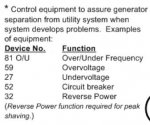The part in italics, particularly
Slip-Mode Frequency Shift Algorithm...
Is certainly enough to baffle me! But that's not too hard.

Islanding Detection in Distribution Networks with Distributed Energy Resources before Main Circuit Breaker Opening
http://www.hrpub.org/download/20131215/UJEEE1-14901525.pdf
The frequency of the MG (microgrid) has a strong relation with the active power of the MG in an islanded operation mode. Therefore, the control strategy of the DGs in an islanding operation mode is the frequency and voltage control. The islanding detection methods should detect the islanding condition as soon as possible with minimum non-detection zone (NDZ). NDZ is "the difference between active and reactive power on the island when islanding cannot be detected by the corresponding method" [4]. The islanding detection method can be classified into the remote methods and the local methods. The local methods monitor the network parameters such as voltage, current, frequency and active power at the terminal of DGs or at the point of common coupling (PCC). The measured parameters have a considerable variation when the islanding condition is occurred. The local methods classified into the active methods and the passive methods. The implementation of the passive methods is simple but their NDZ are large. The active methods have less NDZ than the passive methods but cause the power quality problems in distribution network because of injecting the continual disturbances to it.
Voltage unbalance [5], rate of change of output power [6], rate of change of frequency [7], active frequency drift [8] and Slip-Mode Frequency Shift Algorithm [9] are some of the main local methods. The remote methods monitor the main circuit breaker operation. The main circuit breaker opening causes the islanding condition occurrence. Therefore, these methods detect the islanding conditions by the main circuit breaker opening. The NDZ of the remote methods is minimum but they are expensive methods and their implementation is difficult. Transfer trip scheme [10] and Power line signaling [11] are two example approach of the remote method.
This paper presents a new method for islanding detection in distribution network. This method is based on the zero sequence angle of the current measured at the utility side of the main circuit breaker. Selecting this point as the measuring point causes the fast islanding detection. The measured angle is processed by discrete wavelet transform to extract the characteristics of the measured current, by which the islanding condition can be detected fast and accurately.
----
And you can find these parameters:
The 27, 59, 59N, 81U/O and voltage controlled over current 51C
in some inverter installation manuals.
This is what the POCO around here says.
5.7.10.1.1 Inverter-based PV Generator Equal or Above 500kW
The internal relays are considered as primary protection and the Company
requires one additional utility grade relay to be installed as the secondary
protection if the inverter-based PV size is equal or above 500kW. The 27, 59,
59N, 81U/O and voltage controlled over current 51C (Phase and Ground)
elements shall be activated in the redundant relay. The utility grade relay
failure alarm shall be wired to the Company-designated generator interrupting
device. If the step-up transformer configuration is primary wye grounded -
secondary delta, the over voltage element (59N) shall have the capability of
detecting the Line-Ground faults on the delta side and trip the high side (utility
side) interrupting device to separate the Company’s EPS from the Line-
Ground faults on the delta side (customer side) of the step-up transformer.
5.7.10.1.2 Inverter-based PV Generator Below 500kW
If the inverter is IEEE 1547 compliant and UL-1741 listed, the internal relays
are considered as the only required protection and an additional utility grade
relay is not necessary to be installed.


